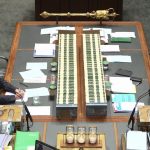Tasmania’s ‘Battery of the Nation’ is an expensive boondoggle in the age of distributed resources

On average, Tasmania has been a net importer of power since Basslink opened, therefore to make the proposed “Battery of the Nation” pumped-hydro scheme work, they will have to import more power than they export from this project.
The losses in transmission are both ways and on short links most of the losses are in the converter stations. So, if the total DC link loss amounts to 4% and the AC links lose another 3% at each end, the hydro system is only 70% efficient on its round trip.
This means that 100 MW produced by a Victorian generator leaves 97 MW at the Victorian DC terminal, 93 MW at the Tassie terminal. 90 MW at the pump x 70% = 63 MW at generator = 61 MW at the Tassie terminal = 59 MW at the Victorian terminal and so just 57 MW is finally delivered at the Latrobe Valley distribution yard.
Then we come to capacity. The line can’t export while it is importing. If imports are only being used to recharge pumped hydro then, from the above, imports must be larger than exports by a ratio of about 100/57 = 1.75:1 imports to exports so the maximum theoretical export time is 36% (1/(1+1.75)). At times when prices are similar in both states, little trade will occur, so it is very hard to see Tassie exporting more than 30% of the time.
A back of the envelope calculation suggests that 2.5 GW of pumped hydro + 2 GW new transmission would cost $5.5 bn. The investment required to strengthen Victoria/SA and Victoria/NSW links would increase this totao to perhaps $6.5b in round figures. Annual maintenance and operation could cost $300 million and capital and interest over 40 years an additional $600 million a year.
Supplying an average of 16,000 MWh per day back to the National Electricity Market would therefore cost $140-200/MWh in fixed costs alone.
After buying power at $40-90 the system will have breakeven power price of $180-300/MWh. Alternatively, wind and batteries in Victoria will have a breakeven price of just $85-120/MWh and solar and batteries probably a bit less. Even using excess Victorian wind and solar to generate hydrogen and feed it into fuel cells would probably cost less than the ‘Battery of the Nation’ pumped hydro idea.
Just to compensate for the additional losses in the Battery of the Nation, the mainland states would need to generate 3,400 GWh per year. If that was generated by a combination of wind and solar, it would require an additional investment of $2.5 bn and incur annual operating and maintenance costs of $60-75m. If the extra generation was from gas, the cost would be much higher. So, the total investment to make a net 2 GW increase in supply to the mainland would be a colossal $9 bn.
The better alternative is for Tasmania to generate an extra 1,000 GWh for own consumption plus an extra 300 MW 24/7 so it can run Basslink at 70% capacity factor as an export only facility. That would require about 7-800 MW of wind and 200-300 MW of new solar, including the plants currently under construction. The cost would be about $1.5-1.7bn with little or no investment in transmission and they could supply power landed in Victoria 24/7 for about $65/MWh.
Minimum summer demand in Tasmania is about 800 MW. If Tasmania had this additional renewable capacity, and assuming peak wind output of 90% combined with minimum hydro and solar, there would probably would only be a few hours a year where minimum generation was more than 1,200 MW. Thus, there would be very few times where local demand plus exports on the existing link was not sufficient to prevent spillage of hydro or curtailment of wind.
Instead of spending $9 billion on the Battery for the Nation project, it would be far better for the NEM to spend $1.5b in Tasmania and the remaining $7.5bn building one hundred 50MW/200MWh battery farms on the mainland. This would generate 5GW of peak power rather than a mere 1.8-2 GW.
These new mainland farms would reduce losses by charging off-peak and discharging near the load. They would also vastly improve grid resilience in the face of natural or man-made disasters. The total storage would be 20 GWh, about the same or possibly more than the pumped-hydro system.
In general, the need for dedicated large scale grid storage is vastly overstated. Wind is never zero and – after allowing for wide dispersion of low-wind-type wind turbines, tracking solar, back up generators and flexible demand – grid storage needs will be much less than current projections.
Most of the remaining storage will be:
• At or near generators for arbitrage and to minimise curtailment due to grid congestion,
• At customers to reduce capacity and peak demand charges while storing behind-the-meter generation from either rooftop solar or CHP plants,
• Occasionally at grid nodes to minimise grid investment, and
• Near loads to improve resilience in the face of fires and storms and shift generation and transmission loads away from peak times.
Pumped hydro in the Adelaide Hills or Port Augusta, or upgrading Shoalhaven, would meet some of these objectives. However pumped hydro in Tasmania or even Snowy II meet none of these needs and therefore cost far more per MW/MWh delivered.
Peter Farley is the President of the Victorian Vernier Society and former Deputy President of the Victorian Committee of Engineers Australia. He has also served as a Director of the Inner Melbourne VET Cluster for more than a decade.













